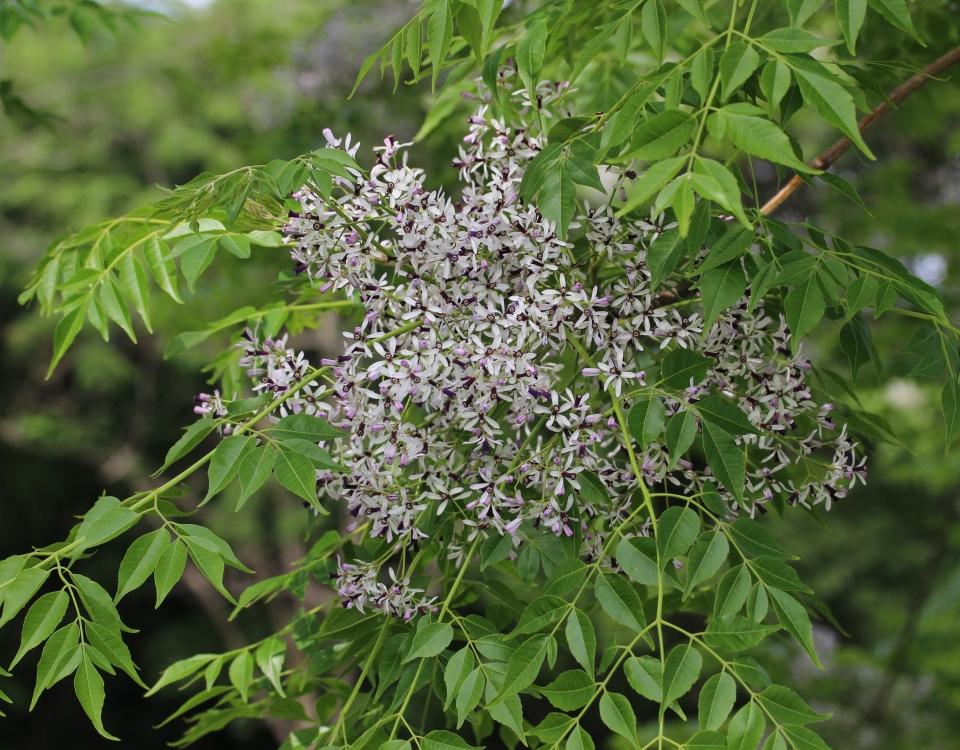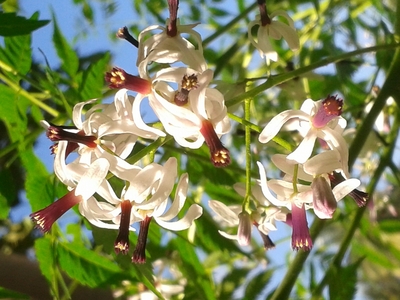
Melia azedarach L. - Chinaberrytree

Melia azedarach L. - Chinaberrytree

Melia azedarach L. - Chinaberrytree
| Plant Category | : | Tree |
| Melghat's Flora's Serial No. | : | |
| Synonym | : | Melia orientalis M. Roem.;
Melia azedarach var. japonica;
Melia toosendan;
|
| Plant Common Name | : | Chinaberry tree, Persian lilac, Pride of India, Bead tree, Lilac tree • Hindi: Bakain • Manipuri: Seizrak • Marathi: Bakan-nimb • Bengali: Bakarjam • Tamil: Kattu vembhu • Nepali: Bakenu, Bakaaino, Mahaaneem |
| Plant Family | : | MELIACEAE |
| Description | : | Tree, up to 12 m tall; young shoots tomentose. Leaves 2-(3)-pinnate, up to 60 cm long; leaflets opposite, elliptic, 2.5-5 cm long, 5-19 mm broad, serrate to sub-serrate, acuminate, often oblique, sub-sessile. Flowers lilac, sweet-scented, in axillary panicles; pedicel 2-3 mm long, puberulous. Calyx 5-6-lobed; lobes c. 2 mm long, acute, pubescent. Petals 7-9 mm long, spathulate to lanceolate, ciliate, imbricate in bud. Staminal tube 6-7 mm long, cylindrical, expanded at the base and apex, 10-striate, with 20 teeth at the apex; anthers sessile, 1 bet¬ween each pair of teeth. Disc glabrous, fused with the ovary base. Ovary usually 5-locular; style 4-5 mm long; stigma capitate. Drupe 1.5-2 cm long, globose, 3-6-seeded, yellow when ripe. Fl. Per. March-April. |
| Plant Location in Melghat | : | on foot hills of Melghat |
| Medicinal Use / Activity | : | The leaf juice is anthelmintic, antilithic, diuretic and emmenagogue. A decoction is astringent and stomachic. A decoction is used to treat Diarrhea. The leaves are used externally to treat skin conditions such as scabies and itch. A decoction is used as a gargle to treat tooth problems and strengthen the gums. The leaves are harvested during the growing season and can be used fresh or dried. The flowers and leaves are applied as a poultice in the treatment of neuralgia and nervous headache. The stem bark is anthelmintic, astringent and bitter tonic. The root bark is emetic, emmenagogue, purgative and vermifuge. It is highly effective against ringworm and other parasitic skin diseases. |
| Plant's Phytochemicals | : | COMPOUNDS: 24-Methylenecycloartanone; gedunin; Meldenin; Nimbinene; Salannin; Sendanal; Vilasinin; (+)-Epicatechin; Azadiradione; Azadirone; Aziridine; betaine; CINNAMIC ACID; Isoscopoletin; KULACTONE; KULINONE; Kulolactone; Melianodiol; MELIANONE; Nimbolidin A; Nimbolidin B; Ohchinin; ohchinolal; Ohchinolide B; ohchnolide A; Orchinol; quercitrin; Sendanin; Sendanolactone; Vanillic acid; vanillin; ACTIVE COMPOUNDS (3): Catechin; Epicatechin; Cinnamic acid; |
| Plant's Current Status | : | |
| Plant's Cross Database Reference | : | 259142 |
| Reference | : | Prabha Y. Bhogaonkar and Pankaj A. Dhole; "Checklist of Flora of Melghat"; Chief Conservator of Forest & Field Director, Melghat Tiger Project, Camp, Amravati (2018 - 2019); Book |
| Reference | : | ~ Prabha Y. Bhogaonkar and Pankaj A. Dhole; "Checklist of Flora of Melghat"; Chief Conservator of Forest & Field Director, Melghat Tiger Project, Camp, Amravati
(2018 - 2019); Book PMID : ~ Omesh Bajpai, Jitendra Pandey and Lal Babu Chaudhary; "Ethnomedicinal Uses of Tree Species by Tharu Tribes in the Himalayan Terai Region of India"; Research Journal of Medicinal Plant (2016); 10(1): 19-41 PMID : |
| Kingdom | : Plantae - Plants |
|---|---|
| Phylum | : Tracheophyta |
| Subkingdom | : Tracheobionta - Vascular plants |
| Superdivision | : Spermatophyta - Seed plants |
| Division | : Magnoliophyta - Flowering plants |
| Class | : Magnoliopsida - Dicotyledons |
| Subclass | : Rosidae |
| Order | : Sapindales |
| Family | : Meliaceae - Mahogany family |
| Genus | : Melia L. - melia |
| Species | : Melia azedarach L. - Chinaberrytree |